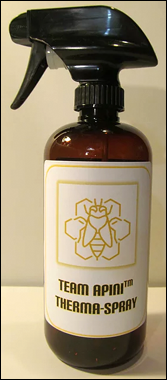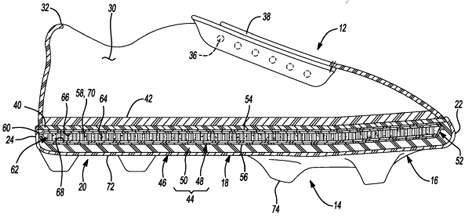 The Phase Change Matters e-mail newsletter is a weekly summary of the latest news and research on phase change materials and thermal energy storage. To subscribe, visit www.puretemp.com/subscribe. For more frequent updates, follow @puretemp on Twitter or visit the Phase Change Matters blog, www.puretemp.com/pcmatters.
The Phase Change Matters e-mail newsletter is a weekly summary of the latest news and research on phase change materials and thermal energy storage. To subscribe, visit www.puretemp.com/subscribe. For more frequent updates, follow @puretemp on Twitter or visit the Phase Change Matters blog, www.puretemp.com/pcmatters.
NEW PRODUCTS
Need a PCM coating on that coat? Ohio company has a solution
 MCMENT Inc., an Ohio company that makes a PCM spray designed for use by consumers, launched a new website last month, teamapini.com, to market the product.
MCMENT Inc., an Ohio company that makes a PCM spray designed for use by consumers, launched a new website last month, teamapini.com, to market the product.
“We have been working on the Team Apini Therma-Spray product for a couple of years to give consumers a way to apply PCM technology to the clothing, bedding or other textile products they may already own,” said Monte Magill, the company’s senior vice president for PCM technologies. The coating is designed to absorb and release thermal energy to enhance thermal comfort.
“It is a water-based formulation containing microencapsulated PCMs and a heat curable binder material to affix the microPCMs to the various textile substrates,” said Magill, who has worked in the PCM industry since the mid-1990s. “We do the final packaging in house but have the microPCMs and the binder formulation contract manufactured.”
Therma-Spray-treated socks are also available on the site. The company has been selling Infinite R PCM products for the building and construction industry on its main site, mcmentinc.com, since 2016.
Magill says more retail products are in the pipeline: “Look for Team Apini thermal underwear, henleys, pillow cases and sheeting, a bunzy protector (seat cushion thermal protector for home, auto, camping, stadium, etc.), heating and cooling packs (for work, first responder and dietary applications) as well as an equestrian line we are working on now for both horse and rider (dressage focus).”
PATENTS
System for providing a single serving of a frozen confection
 U.S. patent application 20190053514 (applicant Sigma Phase Corp., Concord, Mass.):
U.S. patent application 20190053514 (applicant Sigma Phase Corp., Concord, Mass.):
Refrigeration device uses phase change material for cooling air
U.S. patent application 20190063765 (inventor Ray Arjomand, Sparks, Nev.)
“A refrigeration device has a condenser coil that has periodic access to outside air. A time-activated thermostat controls the operation of an evaporator coil that is in thermal contact with a reservoir containing phase change material. A thermally conductive pipe containing antifreeze fluid is connected to a pump that circulates the antifreeze fluid inside the pipe. A first portion of the pipe is inside the reservoir in thermal contact with the phase change material and a second portion of the pipe is near an air fan or connected to a fan coil unit to exchange heat through the pipe between the reservoir and the air blown by the fan or the fan coil unit. The evaporator coil produces a phase change in the phase-changing material in the reservoir at night when outdoor temperature is colder than during day and the phase-change material is used during day to cool air blown by the air fan or the fan coil unit.”
Cushioning arrangement for temperature control of a sole structure

U.S. patent application 20190062614 (applicant Nike Inc., Beaverton, Ore.):
“A sole structure for an article of footwear includes a chamber having a first barrier element, a second barrier element, and a tensile member. The tensile member is disposed within an interior void defined by the first barrier element and the second barrier element. The sole structure further includes a phase change material [70, above] disposed within the interior void and operable between a first state in a first temperature range and a second state in a second temperature range. The first temperature range is from 30° C. to 35° C. and the second temperature range is from 35° C. to 42° C. The sole structure further includes an insulating member disposed between the chamber and a ground contacting surface.”
Self-heating personal covering
U.S. patent application 20190059619 (applicant Aspen Surgical Products Inc., Caledonia, Mich.):
“Disclosed is a self-heating personal covering that includes a first layer and a second layer that is parallel to and opposite of the first layer, and at least a portion of the second layer is fastened to at least a portion of the first layer. The self-heating personal covering also includes at least one heat source positioned between the first layer and the second layer. The at least one heat source is held in a prescribed position by the first layer and the second layer, and includes a material that undergoes an exothermic reaction upon exposure to oxygen. … [At] least one heat distributing structure is a layer of phase change material. The layer of phase change material may be positioned between the at least one heat source and the second layer.”
Three-dimensional polymeric fiber matrix layer for bedding products
U.S. patent application 20190053632 (applicant Serta Simmons Bedding LLC, Atlanta, Georgia)
“A three dimensional polymeric fiber matrix layer including a phase change material coated thereon for use in a bedding product such as a mattress is disclosed. The phase change material is selected to provide improved cooling properties, which along with the free volume provided by the three dimensional polymeric fiber matrix markedly improves temperature management when used in a bedding product.”
Related:
Upcycled mattress nucleus of essential foam elements
IN BRIEF
• The Energy Storage Europe conference and trade fair, set for March 12-14 in Dusseldorf, Germany, includes a number of sessions on thermal energy storage: “Heat Storage – an essential contribution to energy transition,” Oliver Baudson, TSK Flagsol Engineering GmbH; “Advanced Thermal Energy Storage Concepts,” Dr. Robert Pitz-Paal, DLR Institute of Solar Research; “High Temperature Storage,” Doron Brenmiller, Brenmiller Energy; “Material and Component Development for Thermal Energy Storage,” Christoph Rathgeber, ZAE Bayern; and “Thermal Energy Storage for Cost-Effective Energy Management & CO2 Mitigation,” Dr. Dan Bauer, German Aerospace Center – DLR e.V.
• The deadline for submitting paper proposals for next fall’s Advanced Building Skins conference in Bern, Switzerland, is March 10. The list of topics includes thermal performance of phase change materials.
• Thermal battery maker Sunamp Ltd.‘s collaboration with the University of Edinburgh’s School of Chemistry won the “Powerful Partnership” award at the Scottish Knowledge Exchange Awards 2019 last month. The organizations began work on the development of new phase change materials in 2010.
• Croda International Plc has been recognized for its commitment to “a deforestation-free supply chain.” Croda earned an A- in that category in CDP‘s climate change report for 2018, up from a B the previous year. The specialty chemicals company says it has a special focus on palm oil and is committed to supplying RSPO-certified palm oil derivatives.
• Thermal instrumentation maker C-Therm Technologies Ltd. is hosting a free webinar next week, “Quantifying Thermal Performance of Textiles (Warm Feel / Cool Touch).” The webinar, aimed at “anyone working in the product performance testing of textiles and fabrics where temperature regulation is an important function,” will be held at 1 p.m. EST Wednesday.
RESEARCH ROUNDUP
For our full list of recent academic research, see puretemp.com/academic. Here are highlights from the past week:
From Renewable Energy:• Phase Change Material Wallboard (PCMW) melting temperature optimisation for passive indoor temperature control
From Cement and Concrete Research:
• Multiphysics analysis of effects of encapsulated phase change materials (PCMs) in cement mortars
From Journal of Molecular Liquids:
• Preparation and characterization of sodium sulfate pentahydrate/sodium pyrophosphate composite phase change energy storage materials
From Energy and Buildings:
• Performance of heat pump integrated phase change material thermal storage for electric load shifting in building demand side management
• Indoor thermal comfort assessment using PCM based storage system integrated with ceiling fan ventilation: Experimental design and response surface approach
From International Journal of Photoenergy:
• Experimental Study on the Performance of a Phase Change Slurry-Based Heat Pipe Solar Photovoltaic/Thermal Cogeneration System
From Solar Energy:
• Effects of sodium nitrate concentration on thermophysical properties of solar salts and on the thermal energy storage cost
• Red-mud geopolymer composite encapsulated phase change material for thermal comfort in built-sector
From Energies:
• A Novel Encapsulation Method for Phase Change Materials with a AgBr Shell as a Thermal Energy Storage Material
• Latent heat and thermal conductivity enhancements in polyethylene glycol/polyethylene glycol-grafted graphene oxide composites
From International Journal of Refrigeration:
• Preparation and performance of form-stable TBAB hydrate/SiO2 composite PCM for cold energy storage
From Solar Energy Materials and Solar Cells:
• Delignified wood/capric acid-palmitic acid mixture stable-form phase change material for thermal storage
• Molten salt corrosion mechanisms of nitrate based thermal energy storage materials for concentrated solar power plants: A review
From Buildings:
• Thermal Performance of Hollow-Core Slab Ventilation System with Macro-Encapsulated Phase-Change Materials in Supply Air Duct
From International Journal of Heat and Mass Transfer:
• Heat transfer performance of the finned nano-enhanced phase change material system under the inclination influence
From Journal of the Electrochemical Society:
• Effect of High Temperature Circumstance on Lithium-Ion Battery and the Application of Phase Change Material
From Energy:
• High-temperature PCM-based thermal energy storage for industrial furnaces installed in energy-intensive industries